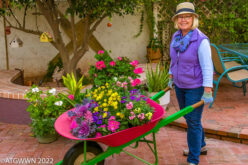A Sense of Place
When our neighborhood was new a family relocating from Virginia moved in next door and quickly put in lawn for their entire landscape. Another family relocated from MN and installed a pool and planted pine trees all around it. Longtime desert gardeners cringe at these home garden stories. Today a strong campaign for regionally appropriate plants fills the garden news. Advocates raise a chorus of voices that sing, “If we live in a desert it is only common sense that we live with desert plants.” Einstein said, “common sense is the collection of prejudices acquired by age 18.” Our common experience of “place” isn’t so common.

The songs sung as children of “purple mountain majesties, home on the range or down the lazy river,” influence our connection to the land. The books we read describing prairies, the wild west or the craggy coasts also provided grounding in place. As a child if we lived with a lush, wet, green expanse of lawn for play and pretend or swam in a lake surrounded by pine trees our sense of place in nature is firmly fixed to include those elements. Relocating to a new region and adjusting our sense of place is a series of discoveries.
Demonstration Gardens provide an opportunity to experience a new place. When we are encouraged to plant our home gardens differently than we envision we often resist. It is quite difficult to get excited about low water use plants while looking at three gray sticks of a desert milkweed plant at the local nursery. A demonstration garden lets us see plants in a mature state mixed with companion plants highlighting their best (or worst) features.
Every region has demonstration gardens relevant to their area. As you travel you will see demonstrations of defensive planting practices to increase safety for homes at risk for wildfires. Other gardens illustrate plants resistant to deer, or extreme temperatures. The Extension office gardens provide educational demonstrations of good garden practices.

The Scottsdale Xeriscape Garden demonstrates the “beauty of saving water” and February is a wonderful temperate time of year to explore this 5.5-acre garden. If you drive Hayden road and turn on McDonald drive you get only a glimpse of the garden. The dynamic building accented with stone and steel sculpture that grabs your attention is a water treatment plant. If you stop, parking along Hayden road and wander in past the busy dog parks you will find your way into a shady terrace.
Here you find a hummingbird paradise with aloes, fairy dusters, orange bells, red yucca and desert willow. Sitting on the winding low walls you can watch the flying jewels moving busily between the blooms. Walking north past agaves, blue blooming rosemary and barrel cactus you find the water fountain terrace. This large plaza with shade provides a view of patio space one could imagine on a smaller scale in our own desert homes.

Walking south you pass two giant cottonwood snags alive with birds. Hawks perch here and keep the rabbit population in check. Further on you come to the mesquite bosque.

This circling green ribbon of mesquite trees is still maturing yet it will create shade to protect visitors from the hot sun. The trees are watered with the water sent their way from the rock work water harvest basin.

Terraced Cascade by Lorna Jordan incorporates flagstone and round stones to create walls, steps, paths and seeps for the water to flow. Located in the Indian Bend Wash, an area known for extreme heat and water flow, this work of art serves as a practical water harvesting system supplementing the regular irrigation. The xeriscape garden, adjacent to the Chaparral Water Treatment Plant, conceals a buried reservoir with a holding capacity of 5.5 million gallons of water.
The Terraced Cascade is beautiful to see on a sunny day but if it starts raining and the water begins to flow it would be worth a trip to the garden just to see it in action! Surrounding the area are the regionally appropriate plants in a variety of shapes, colors and textures. This provides demonstration of a desert garden space from which ideas for one’s own garden could be shaped.

In our home we look out our window to our garden and expect to see our image of a sense of place. For me that includes a small space of grass and pink geraniums. After years of trial and error, and many more walks through the desert garden, more of our plant palettes begin to reflect this place in central Arizona.
originally published in Roots & Shoots
@http://cals.arizona.edu/maricopa/garden/mgcentral/uploads/Feb11.pdf


Thank you! This is such a perfect article…
I hope you can visit here sometime and see all of the stone work. Such different colors of stone in the Southwest compared to the Northwest.